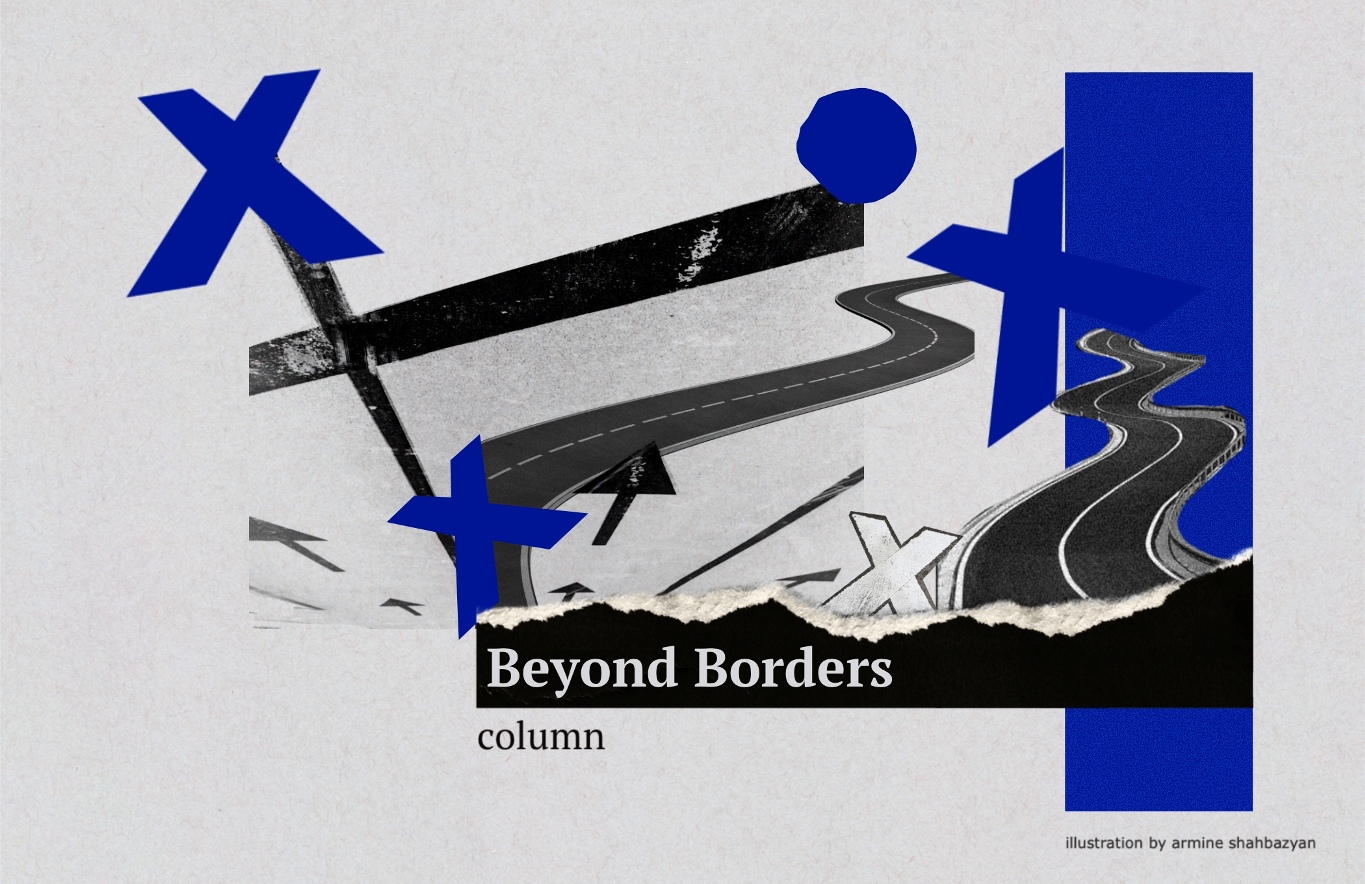[Beyond Borders]
This column explores the key issues shaping life in the South Caucasus, focusing on how the divergent paths of Georgia, Armenia and Azerbaijan reflect the region’s complex histories, economic developments, and political shifts. While new generations in these countries grow more isolated from one another due to language barriers and conflicting national trajectories, the same is true for local policymakers, who are often more familiar with distant capitals than their immediate neighbors. Each nation seeks its own path, sometimes in conflict with others, while international actors often treat the region as a whole, reluctant to craft policies specific to individual states. Drawing on personal experience with the region’s revolutions, conflicts and transformations, Olesya brings you Beyond Borders—a column exploring how decisions made in one corner of the South Caucasus impact all who live there.

Listen to the article.
While it remains uncertain what will come of the grand promises to halt the war in Ukraine, one thing is clear: in the short term, Russia’s focus will be consumed almost entirely by Ukraine’s fate, leaving little room for other geopolitical concerns. The long-term picture is harder to discern, but that does not necessarily imply a return to Russia’s former influence over the South Caucasus.
Donald Trump’s return has set the clock ticking on his pledged shifts in America’s Ukraine policy. Although Moscow has signaled its readiness for negotiations, the intensity of military operations remains unchanged. In recent months, reports of Russian advances into Ukraine have surfaced with near-clockwork regularity. Meanwhile, Western nations continue to impose sweeping sanctions that will deepen Russia’s economic woes for years to come.
This state of affairs hardly suggests an imminent end to the Russian invasion of Ukraine, almost in its fourth year, as both sides escalate their demands and ambitions. However, new diplomatic initiatives will inevitably trigger ripple effects beyond Ukraine. The key questions dominating conversations in the halls of power across the South Caucasus remain: To what extent will Russia be preoccupied in the upcoming Ukrainian peace talks? How will this impact the war’s intensity? And, crucially, what kind of Russia will emerge from this conflict?
A Lonely Region
Anxiety in the South Caucasus is palpable. More than three decades after the Soviet Union’s collapse, Armenia, Azerbaijan and Georgia remain bound to Moscow by a web of historical ties. Despite this, the past three years have been different. Russia’s overwhelming preoccupation with Ukraine has not only diverted its attention from the region but has emboldened local leaders to maneuver in pursuit of their own interests.
For Azerbaijan, Moscow stood by as Baku first blockaded and then launched a one-day military operation to reclaim Nagorno-Karabakh and the ethnic cleansing of the Armenians. Last year, Russia preemptively withdrew its peacekeeping forces in Nagorno-Karabakh ahead of schedule, cementing Azerbaijan’s complete victory over the enclave.
Armenia, a formal ally of Moscow, has openly courted deeper ties with the West. In a striking move, Armenian authorities secured the Kremlin’s consent to remove Russian border guards from key strategic locations, including the frontiers with Azerbaijan and Iran, as well as Yerevan’s airport—a proposal Moscow could hardly refuse in its current predicament.
Georgia, under the ruling Georgian Dream party with its soft stance on Russia and its fraught relationship with the West, may appear an exception. But in reality, it is not. For over a year now, Georgia has been experiencing political turbulence, with regular street demonstrations that have continued non-stop for almost three months. Russia has many tools to pacify this situation and halt the protests—for instance, by leveraging its military presence in Abkhazia and South Ossetia. Yet, this has never happened. Nearly a year since the start of the political crisis, Russia has refrained from direct interference. Its conspicuous absence from the deepening crisis in Tbilisi underscores its singular focus on Ukraine, leaving no bandwidth for secondary priorities.
Never before have these three nations found themselves so wholly left to their own devices. The regional order that took shape in the post-Soviet era—with Russia as the central power—is evolving. How firmly this transformation will take hold, and to what extent it will continue, depends largely on developments in Ukraine.
Misplaced Expectations
With Russia preoccupied, other regional players have sought to fill the power vacuum. Turkey holds the strongest hand, with a close alliance with Azerbaijan and a strategic partnership with Georgia. A normalization of ties with Armenia could further shift the balance, if not making Turkey a new Russia in the region, then at least altering its standing in fundamental ways.
Iran, meanwhile, has voiced ambitions for a greater role, opening a consulate in Kapan and occasionally floating the idea of deploying observers—read: military personnel—to southern Armenia. Yet, Iran’s core interest lies in maintaining the status quo rather than expanding its influence. This could explain why Iran has made little effort to engage with Georgia and why its relationship with Azerbaijan continues to fluctuate.
In theory, this period of Russian distraction could have provided an opportunity for the South Caucasus to take a major leap forward—advancing development, strengthening statehood, and gaining greater regional agency—if only its nations could agree among themselves. Armenia and Azerbaijan initially signaled a promising shift. In late 2021, months before Russia’s full-scale invasion of Ukraine, their leaders met not in Moscow, as tradition dictated, but in Brussels. This departure from decades-old precedent opened the door for Yerevan and Baku to shape a new regional dynamic amid Russia’s absence.
Yet, what began with promise soon descended into renewed violence. Azerbaijan’s cross-border attacks in 2022 and its subsequent takeover of Nagorno-Karabakh extinguished hopes for a swift regional transformation. Instead, fears of all-out war have surged, along with a growing sense of helplessness and disillusionment with the broader international order.
Baku, for its part, continues to assert its ambitions as a regional power. This is evident in its shifting stance in peace negotiations with Yerevan, delaying the signing of a final treaty that could pave the way for Turkish-Armenian rapprochement. Azerbaijan appears to believe it can maintain its influence over Armenia through force—keeping troops stationed in key border areas within Armenia itself. Yet, earning respect through fear is not how the South Caucasus has traditionally operated—it is the Russian model of power projection.
Will Russia Return?
If diplomatic negotiations gain traction, Moscow will remain fixated on Ukraine in the near term, leaving little capacity for intervention elsewhere. How long this state of affairs will last is uncertain. But it is unlikely to be a period when Russia rekindles its involvement in the South Caucasus—whether through a new war or attempting to rupture Armenia’s Western outreach.
Russia’s posture in the post-Ukraine war landscape will hinge on three factors: the stability of any negotiated settlement, the extent to which it satisfies the warring parties, and Russia’s ability to sustain military confrontation should peace fail to align with its objectives.
Notably, Russia’s demands on Ukraine have only expanded from their initial scope before the current war. What once centered on Crimea now extends to control over additional Ukrainian territories, as well as an insistence on halting Western military aid and ensuring Ukraine’s neutrality. Negotiations of this magnitude will be protracted, and a swift resolution is far from guaranteed.
Even in a scenario where Russia emerges victorious, it does not automatically follow that Moscow will pivot toward other regional conflicts. True, the Kremlin might decide that its battle-hardened military machine must keep running. Yet, war is costly, unpredictable, and fraught with risks. Should peace take hold in Ukraine, Moscow may well choose restraint (though this could mean a flood of Russian weapons hitting the market at lower prices).
What happens in the long term—10 or 20 years after the war’s conclusion—is even murkier. Some point to Russia’s resurgence after the turmoil of the 1990s, when high oil and gas prices fueled a geopolitical comeback. But will a similar catalyst emerge? And should the countries of the South Caucasus even be waiting for such an eventuality, limiting their own prospects for stronger, more independent statehood for themselves in the process? As an old Russian proverb warns: “He who fears the wolf should stay out of the forest.” Yet perhaps instead of lingering at the forest’s edge, this may be the time to take decisive steps—especially for Armenia, though the entire region could benefit.


